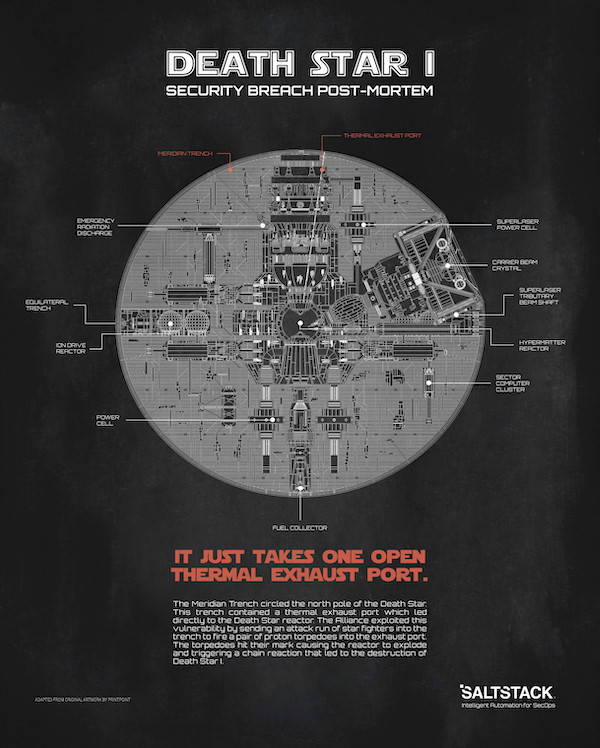What’s your background?
I’ve worked in digital marketing and demand gen for over 15 years before joining SaltStack.
I joined SaltStack because I knew I could make a big difference, since they didn’t have an active demand gen program yet.
Now I’m responsible for all things related to driving leads, including advertising, events, webinars, trade shows, SEO, web optimization, field marketing, you name it.
What does SaltStack do?
SaltStack helps enterprise IT professionals remotely control and secure IT servers, VMs, containers, network devices, and other IT infrastructure at scale.
We help IT teams manage and simplify their networks and cloud infrastructure with an abstraction layer, regardless of whether they’re strictly on premise, fully in the cloud, or running a hybrid cloud.
We also help SecOps teams maintain security and compliance through automated remediation and policy customization.
What’s your inbound customer journey?
Customers typically first discover SaltStack through PR and SEO, which is our most critical tool to drive awareness.
We show up on page one for terms that are extremely relevant to our business, like ‘SecOps’ and longer-tail: ‘What is SecOps?’
We also drive awareness by staying engaged in social media, particularly on LinkedIn, Twitter and Facebook.
And we actively work with our PR agency to promote home-grown research like our State of XOps report. (The report has also helped us show up on page one for the search term “XOps.”)
After we drive initial awareness, we drive ongoing engagement with prospects through a wide range of inbound marketing programs.
We use Marketo for email marketing, although the nurture/drip campaigns aren’t as effective as we’d like. So we’ve had to think of other ways to engage our community.
So we also do a lot of advertising, including retargeting tactics. We host webinars.
We’re still in the experimental stages when it comes to prospect engagement, so we generally do anything we can to move people through the inbound funnel.
To generate leads, we have a variety of gated assets like webinars, white papers, and videos.
What are your most successful inbound marketing practices?
SEO is definitely our most successful inbound marketing practice so far.
We’ve driven lots of new users to our site by getting to page one of Google search results for terms that are completely relevant to what we do, like “SecOps” and “XOps.”
That rise in website traffic has given us a chance to build awareness and drive up the volume of leads through demo signups and “contact us” conversions.
Also, playful campaigns have spread like wildfire to Reddit and Slickdeals, really spiking traffic and going viral.
For example, our Death Star Poster giveaway went viral after we published a blog post that talks about how “Todd Tarkin” was responsible for the destruction of the Death Star by leaving a thermal port open (analogous to our customer or prospects leaving a port open on their devices).

Since the Death Star Poster went viral, we’ve seen a 300% to 400% boost in organic conversions to ship a free poster.
Everyone likes free stuff and mailing a poster is a fairly cheap cost per conversion compared to other B2B options out there.
While it isn’t easy to keep a giveaway focused on our ideal customer persona (ICP), the low cost of conversion allows us to have some broader targets.
And you never know how that will play out over time. Maybe students or interns will remember SaltStack when they enter the field as IT professionals. Or maybe other marketers will share the posters for their viral nature, bringing us backlinks and social media mentions.
Another example of a playful campaign is a sticker we came up with.
We were seeing that a lot of companies were saying they remediated security issues automatically.
We found out that they were creating helpdesk tickets via advanced workflows but not actually remediating.
So we made the sticker based on the Princess Bride character Inigo Montoya. “Remediate: I do not think it means what you think it means.”
It was a huge hit!
What’s your advice for startups just beginning inbound marketing?
Be creative.
You need to strike a balance between professionalism and creativity.
Some kinds of marketing will get people to think of your brand as a serious, professional brand, like in-depth white papers. These will help you punch above your weight class.
Other kinds of marketing will connect with people on a more personal level because they’re super creative and fun.
Strike a balance between these two types of marketing.
Don’t be afraid to take a risk and be creative and fun with your marketing. But do it in a way that accentuates your more serious messaging.
What’s your advice for startups taking their inbound marketing from intermediate to advanced?
Go big.
Write an e-Book.
Produce a short film.
Book your executives as speakers on big stages at big events.
Make your customers look like heroes at industry trade shows, not just at your own conferences.
Get involved in political issues that resonate with your mission statement.
Don’t be afraid to take a stand and lose customers along the way. People want to do business with other people of character and integrity. Be loud and clear about that.
Also, put on your internal sales hat and win the executive support you need to put marketing dollars into initiatives with no expectations of a direct return on investment.
This will give you the freedom you need to engage in trial and error. Through experimentation, you can find the way to reach a more advanced level in your inbound marketing.
Where is the future of inbound marketing going?
It might be a pipe dream, but I hope that someday we can draw people in with great inbound marketing so effectively that marketers no longer feel the need to overstep their bounds on privacy issues.
I also see the future of inbound marketing moving toward community building.
The best way to sell a customer is to get them to see your products through the eyes of other customers who already love what you do.
One great way to build a community is to take the freemium model to a whole new level.
For example, our technology is based on open source.
By working with the open source community, we’ve built an unmatched camaraderie that creates countless ambassadors for our technology.
Ask yourself, “Is there anything I can give away that will enhance people’s lives for free today, but also eventually make them a customer?”
It’s true that top-of-funnel free offers can sometimes take years to convert to a paid customer. But they can also build a rich community of ambassadors who do the selling for you.
And the great thing about having built a community is that you can simply focus on creating a great experience for free users, knowing they’ll be willing to listen to you when you upsell.
For a software company, open source in particular can improve the quality of your technology up to a level you wouldn’t get without massive numbers of beta testers.
Building a community of ambassadors around an open source product also has some unique product packaging advantages.
You can look for patterns in customer behavior to learn what combinations of products and features your customers like. Then you can enhance, expand, and package the product in a way that will turn your open source project into a large community of fans and brand ambassadors.
Where can people learn more about you and your company?
Ryan Smith on LinkedIn: https://www.linkedin.com/in/ryandanielsmith/
Website: https://www.saltstack.com/
Twitter: https://twitter.com/SaltStack
Facebook: https://www.facebook.com/SaltStack/
LinkedIn: https://www.linkedin.com/company/salt-stack-inc/
